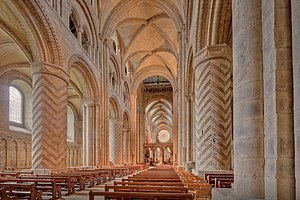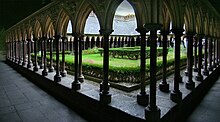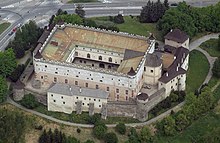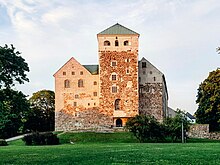A | B | C | D | E | F | G | H | CH | I | J | K | L | M | N | O | P | Q | R | S | T | U | V | W | X | Y | Z | 0 | 1 | 2 | 3 | 4 | 5 | 6 | 7 | 8 | 9
This article needs additional citations for verification. (November 2018) |

Medieval architecture was the art of designing and constructing buildings in the Middle Ages. Major styles of the period include pre-Romanesque, Romanesque, and Gothic. The Renaissance marked the end of the medieval period, when architects began to favour classical forms. While most surviving medieval constructions are churches and military fortifications, examples of civic and domestic architecture can be found throughout Europe, including in manor houses, town halls, almshouses, bridges, and residential houses.
Guilds were formed by craftsmen during this period to organize their trades. Architects were usually master masons (Magister lathomorum), and were typically responsible for the structural engineering of their buildings, for ensuring that they were stable, unlike in later periods.
Styles
Pre-Romanesque

The pre-Romanesque period of medieval architecture lasted from the beginning of the Middle Ages (around 500AD) to the emergence of the Romanesque style in the 10th century. Much of the notable architecture from the period comes from France and Germany, under the Merovingians and the Carolingians and the Ottonians. Nonetheless, other regions have strong architectural heritage from this period, including Iberia (especially in Asturias), Croatia, and Great Britain. In Lombardy, the pre-Romanesque style included many Romanesque features and is therefore known as the First Romanesque.
Romanesque
Romanesque, prevalent in medieval Europe during the 11th and 12th centuries, was the first pan-European style since Roman Imperial architecture and examples are found in every part of the continent. The term was not contemporary with the art it describes, but rather, is an invention of modern scholarship based on its similarity to Roman Architecture in forms and materials. Romanesque is characterized by a use of round or slightly pointed arches, barrel vaults, and cruciform piers supporting vaults. Romanesque buildings are widely known throughout Europe.
The spread of Romanesque architecture through Europe has been described as "revolutionary"[by whom?]. This style is sometimes called Anglo-Norman, though it continues under the Angevin and Plantagenet rulers. Motifs of Roman origin were common to Norman and Anglo-Saxon architectural styles. Though usually classed broadly as "Romanesque", the period of architecture can now be divided into two stages. The first stage from 1070 A.D. to 1100 A.D. saw the style emerge during the rebuilding of many great churches, Full boxes, and monasteries (surviving examples include the Durham Cathedral, Norwich Cathedral and the Peterborough Cathedral). The second stage lasted from 1100 A.D. to 1170 A.D. when many smaller churches were built and renovated. During this time, the style became more detailed and ornamental. Identifying these latter churches is made difficult due to something called the Saxo-Norman overlap, where many Anglo-Saxon aspects are present in the masonry. The Church at Kilpeck is identified as 12th century based on its shallow and flat buttresses, emphatic corbel table and apse.[1]
Gothic
The various elements of Gothic architecture emerged in a number of 11th and 12th century building projects, particularly in the Île de France area, but were first combined to form what we would now recognise as a distinctively Gothic style at the 12th century abbey church of Saint-Denis in Saint-Denis, near Paris. Verticality is emphasized in Gothic architecture, which features almost skeletal stone structures with great expanses of glass, pared-down wall surfaces supported by external flying buttresses, pointed arches using the ogive shape, ribbed stone vaults, clustered columns, pinnacles and sharply pointed spires. Windows contain stained glass, showing stories from the Bible and from lives of saints. Such advances in design allowed cathedrals to rise taller than ever.
Functions

Religious architecture
The Latin cross plan, common in medieval ecclesiastical architecture, takes the Roman basilica as its primary model with subsequent developments. It consists of a nave, transepts, and the altar stands at the east end (see Cathedral diagram). Also, cathedrals influenced or commissioned by Justinian employed the Byzantine style of domes and a Greek cross (resembling a plus sign), with the altar located in the sanctuary on the east side of the church.
Military architecture

Surviving examples of medieval secular architecture mainly served for defense. Castles and fortified walls provide the most notable remaining non-religious examples of medieval architecture. Windows gained a cross-shape for more than decorative purposes, they provided a perfect fit for a crossbowman to safely shoot invaders from inside. Crenellated walls (battlements) provided shelters for archers on the roofs to hide behind when not shooting invaders.
Civic architecture
While much of the surviving medieval architecture is either religious or military, examples of civic and even domestic architecture can be found throughout Europe. Examples include manor houses, town halls, almshouses and bridges, but also residential houses.
Regions
Central Europe

Byzantine Empire
Bulgarian Empire

Scandinavia

Kievan Rus
See also
- Medieval Serbian architecture
- List of medieval stone bridges in Germany
- List of medieval bridges in France
References
- ^ Cannon, Jon (10 July 2014). Medieval Church Architecture. ISBN 9780747815327.
Further reading
- Braun, Hugh, An Introduction to English Mediaeval Architecture, London: Faber and Faber, 1951.
- "Building the House of God: Architectural Metaphor and The Mystic Ark," Codex Aquilarensis: Revista de arte medieval (2016)
- Fletcher, Banister; Cruickshank, Dan, Sir Banister Fletcher's a History of Architecture, Architectural Press, 20th edition, 1996 (first published 1896). ISBN 0-7506-2267-9. Cf. Part Two, Chapter 13.
- Hillson, J., Buchanan, A., Webb, N , Digital Analysis of Vaults in English Medieval Architecture, London: Taylor & Francis (2021).
- Rudolph, Conrad, "Building-Miracles as Artistic Justification in the Early and Mid-Twelfth Century," Radical Art History: Internationale Anthologie, ed. Wolfgang Kersten (1997) 398–410.
- Rudolph, Conrad, "The Architectural Metaphor in Western Medieval Artistic Culture: From the Cornerstone to The Mystic Ark," The Cambridge History of Religious Architecture, ed. Stephen Murray (2016).
- Rudolph, Conrad, "Medieval Architectural Theory, the Sacred Economy, and the Public Presentation of Monastic Architecture: The Classic Cistercian Plan," Journal of the Society of Architectural Historians 78 (2019) 259–275.
External links
>Text je dostupný pod licencí Creative Commons Uveďte autora – Zachovejte licenci, případně za dalších podmínek. Podrobnosti naleznete na stránce Podmínky užití.
Wikipedia:Verifiability
Special:EditPage/Medieval architecture
Help:Referencing for beginners
Help:Maintenance template removal
File:Durham Cathedral Nave.jpg
Romanesque architecture
Nave
Durham Cathedral
Architecture
Middle Ages
Pre-Romanesque
Romanesque architecture
Gothic architecture
Renaissance
Renaissance architecture
Church (building)
Manor house
Town hall
Almshouse
Bridge
Guild
Master mason
Pre-Romanesque art and architecture
File:Santa María del Naranco, Oviedo edited.jpg
Santa María del Naranco
Asturian architecture
Merovingian art and architecture
Carolingian architecture
Ottonian architecture
Iberian pre-Romanesque art and architecture
Asturian architecture
Croatian pre-Romanesque art and architecture
Anglo-Saxon architecture
First Romanesque
Romanesque architecture
Roman Architecture
Wikipedia:Manual of Style/Words to watch#Unsupported attributions
Angevin kings of England
Plantagenet
Durham Cathedral
Norwich Cathedral
Peterborough Cathedral
Masonry
Church of St Mary and St David, Kilpeck
Buttresses
Corbel table
Gothic architecture
Île de France
Saint Denis Basilica
Saint-Denis, Seine-Saint-Denis
Paris
Flying buttress
Arch
Ogive
Stained glass
Bible
Saint
File:Normandie Manche Mont1 tango7174.jpg
Mont Saint-Michel
Church architecture
Cistercian architecture
Latin cross
Basilica
Nave
Transept
Altar
Cathedral diagram
Cathedral
Justinian I
Byzantine architecture
Greek cross
File:Zolyomcivertanlegi1.jpg
Zvolen Castle
Slovakia
Castle
Tower house
Castle
Fortified wall
Crossbow
Battlement
Romanesque secular and domestic architecture
Gothic secular and domestic architecture
Manor house
Town hall
Almshouse
File:Castillo de Malbork, Polonia, 2013-05-19, DD 04.jpg
Malbork Castle
Poland
Brick Gothic
Czech Gothic architecture
Romanesque architecture
Austrian Walled Towns
Byzantine architecture
File:Baba Vida Klearchos 1.jpg
Baba Vida
Bulgaria
Architecture of the Tarnovo Artistic School
Medieval Scandinavian architecture
File:Castle of Turku 3.jpg
Turku Castle
Finland
Architecture of Kievan Rus'
Russian church architecture
Medieval Serbian architecture
List of medieval stone bridges in Germany
List of medieval bridges in France
ISBN (identifier)
Special:BookSources/9780747815327
Banister Fletcher
Banister Fletcher's a History of Architecture
ISBN (identifier)
Special:BookSources/0-7506-2267-9
Template:History of architecture
Template talk:History of architecture
Special:EditPage/Template:History of architecture
History of architecture
Timeline of architectural styles
History of construction
BCE
Neolithic architecture
Architecture of Mesopotamia
Ancient Egyptian architecture
Minoan civilization#Architecture
Mycenaean Greece#Architecture
Etruscan architecture
Classical architecture
Ancient Greek architecture
Ancient Roman architecture
Herodian architecture
Iranian architecture#Pre-Islamic architecture of Persia
Achaemenid architecture
1st millennium
Sasanian architecture
Byzantine architecture
Architecture of Kievan Rus'
Russian church architecture
Islamic architecture
Umayyad architecture
Moorish architecture
Abbasid architecture
Fatimid architecture
Iranian architecture#Islamic architecture of Persia
Medieval Scandinavian architecture
Pre-Romanesque art and architecture
Carolingian architecture
Romanesque architecture
Galician school (architecture)
Ottonian architecture
Norman architecture
Hoysala architecture
Vijayanagara architecture
Western Chalukya architecture
Great Seljuk architecture
Anatolian Seljuk architecture
Mamluk architecture
Timurid architecture
Ottoman architecture
Indo-Islamic architecture
Romano-Gothic
Gothic architecture
Sondergotik
Inca architecture
Aztec architecture
Renaissance architecture
Plateresque
Manueline
Palladian architecture
Spanish Colonial architecture
Portuguese colonial architecture
Mughal architecture
Sikh architecture
Baroque architecture
Andean Baroque
Czech Baroque architecture
Dutch Baroque architecture
Edwardian Baroque architecture
English Baroque
French Baroque architecture
Italian Baroque architecture
Maltese Baroque architecture
Petrine Baroque
Elizabethan Baroque
Naryshkin Baroque
Baroque architecture in Portugal
Siberian Baroque
Ukrainian Baroque
Industrial architecture
British industrial architecture
Revivalism (architecture)
Byzantine Revival architecture
Neo-Byzantine architecture in the Russian Empire
Serbo-Byzantine Revival architecture
Colonial Revival architecture
Egyptian Revival architecture
Gothic Revival architecture
Mayan Revival architecture
Mediterranean Revival architecture
Mission Revival architecture
Monumentalism
Baroque Revival architecture
Rococo architecture
Neoclassical architecture
Moorish Revival architecture
Neo-Manueline
Pueblo Revival architecture
British Queen Anne Revival
New World Queen Anne Revival architecture
Renaissance Revival architecture
Romanian Revival architecture
Russian Revival architecture
Spanish Colonial Revival architecture
Territorial Revival architecture
Tudor Revival architecture
Art Nouveau
Jugendstil
Liberty style
Modern Style (British Art Nouveau style)
Modernisme
Rationalism (architecture)
Mycenaean Revival architecture
Modern architecture
Prairie School
Expressionist architecture
Czech Cubism
De Stijl
Bauhaus
Constructivist architecture
New Objectivity (architecture)
Streamline Moderne
Totalitarian architecture
Fascist architecture
Nazi architecture
Stalinist architecture
International Style (architecture)
Functionalism (architecture)
Futurist architecture
Organic architecture
Art Deco
Stripped Classicism
Postconstructivism
PWA Moderne
Googie architecture
Brutalist architecture
Structuralism (architecture)
Postmodern architecture
Blobitecture
High-tech architecture
Arcology
Critical regionalism
Neo-futurism
Deconstructivism
Neomodern
New Classical architecture
Contemporary architecture
Chinese architecture
Colonial architecture
Architecture of India
Dravidian architecture
Hindu temple architecture
Japanese architecture
Korean architecture
Mesoamerican architecture
Maya architecture
Newa architecture
Portuguese Architecture
Russian architecture
Spanish architecture
Somali architecture
Template:Middle Ages
Template talk:Middle Ages
Special:EditPage/Template:Middle Ages
Middle Ages
Early Middle Ages
Migration Period
Historiography of the fall of the Western Roman Empire
Barbarian kingdoms
Late antiquity
Persecution of pagans in the late Roman Empire
Christianity in the Middle Ages
Christianization
Spread of Islam
Papal States
First Bulgarian Empire
Francia
Kingdom of Croatia (925–1102)
History of Anglo-Saxon England
Viking Age
Carolingian Empire
Old Church Slavonic
Republic of Venice
Civitas Schinesghe
Kievan Rus'
Byzantine Empire under the Justinian dynasty
Reconquista
High Middle Ages
Norman Conquest
Holy Roman Empire
Second Bulgarian Empire
Kingdom of Georgia
Kingdom of Poland
Feudalism
Republic of Genoa
East–West Schism
Investiture Controversy
Crusades
Republic of Florence
Scholasticism
Capet–Plantagenet feud
Christian monasticism
Medieval commune
Manorialism
Medieval Warm Period
Mongol invasion of Europe
Kingdom of Portugal
Late Middle Ages
Hundred Years' War
Wars of the Roses
Hussite Wars
Updating...x
Text je dostupný za podmienok Creative
Commons Attribution/Share-Alike License 3.0 Unported; prípadne za ďalších
podmienok.
Podrobnejšie informácie nájdete na stránke Podmienky
použitia.

